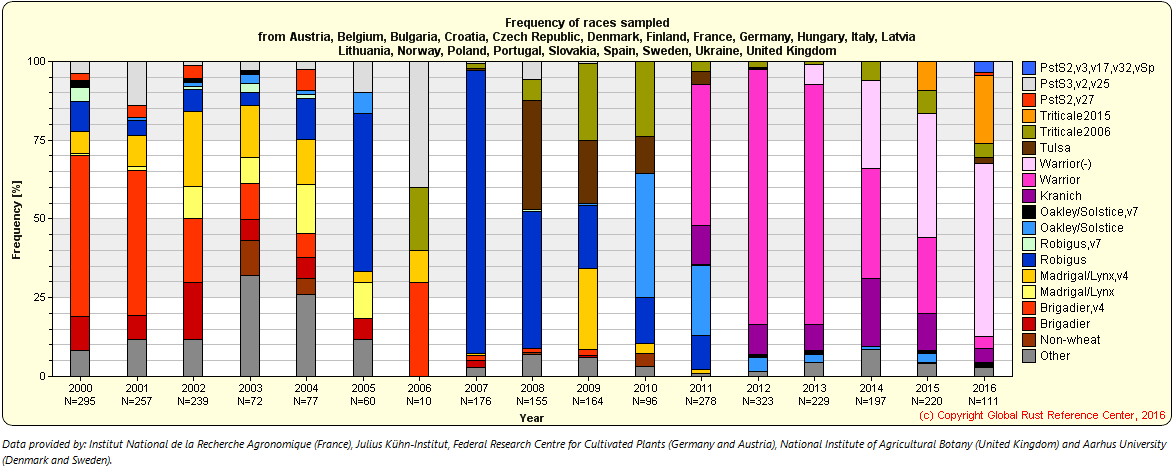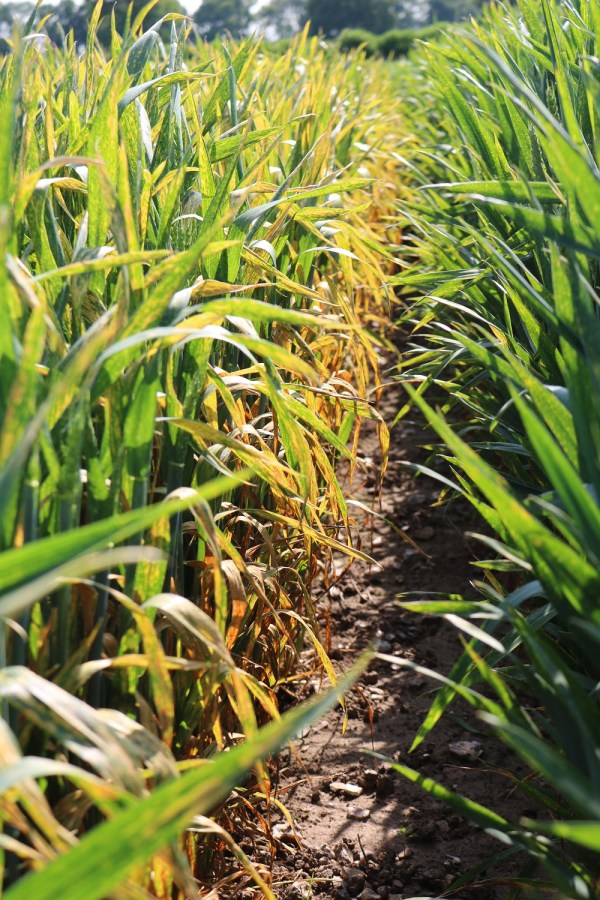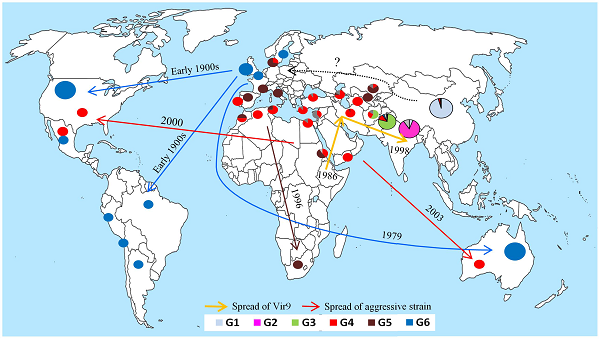There’s a battle farmers, plant breeders and researchers have fought across the globe over three millennia, against an adversary that continues to take on new forms. CPM charts the progress in plans to outsmart yellow rust.
We discovered there had been a complete shift in the genetic make-up of the UK yellow rust population.
By Tom Allen-Stevens
Picture the scene: it’s 25 April, and a solemn group has gathered about five miles out from Rome. An unweaned puppy is brought to a makeshift alter, its throat is slit and a masked priest murmurs a prayer as he performs a precise and well rehearsed ritual with the blood and disembowelled entrails.
This is crop protection in around 700BC. The sacrifice is to appease the Roman god Robigus, feared and revered as the deity that can bring a harvest of plenty or ravage the crops with rust. It’s this very same disease that even today is a major concern for millions of farmers, from the Americas to the Himalayas, from the Green belt of Eritrea to the arable plains of southern Sweden.
Greatest concern
The pathogen of greatest concern in Europe today is wheat stripe rust, or yellow rust, caused by the fungus Puccinia striiformis. These days it rarely causes an individual crop to lose more than 10% of its yield and existing chemistry provides adequate control, according to a study carried out by Dr Colin Wellings of the University of Sydney, Australia. But its reach and spread puts the estimated annual loss from the disease well into billions of US dollars.
What’s more, it’s evolving. Rust generally reproduces asexually and needs green plant material to do so, although the fungal spores may survive a couple of weeks on dry wheat leaves or on contaminated clothing. This means varietal resistance is the first line of defence, and breeders are credited with success at introducing genes with strong resistance to the pathogen.
But yellow rust has fought back. A small mutation in an isolate can render a resistant variety susceptible, with dramatic consequences – the breakdown in the UK of Rothwell Perdix in 1966, Joss Cambier in 1969 and Sleijpner in 1988 are well documented and enshrined in the memory of older breeders and trials managers.
As a result, breeders across Europe are striving to build in more durable, long-lasting forms of resistance that are less vulnerable to changes in the pathogen population and draw their strength from a number of genes, rather than just one or two. Genetic markers are used to identify and stack resistance from a number of sources.

The Warrior race appeared across wide areas of Europe and dominated the population in just the first year of detection, says Mogens Hovmøller.
But one recent development has stunned breeders and the research community and brought about a complete rethink on yellow rust: the Warrior race. “It’s the pace with which Warrior took over,” notes Prof Mogens Hovmøller of Aarhus University in Denmark. “It appeared across wide areas of Europe and in many countries within the same season and dominated the population in just the first year of detection.”
The development of this new appearance has been tracked by the Global Rust Reference Centre (GRRC), coordinated by Mogens Hovmøller. The centre draws from information and samples provided by a global network of leading research scientists and monitors progress of major rust pathogens around the world.
“The new race was then followed by Warrior(-), that’s related but not the same, although we believe it’s from the same source region. This currently dominates the population across Europe,” he reports.
Other serious, recent incursions have caused widespread concern across Europe. “The Kranich race is one that’s been found across much of Scandinavia and Poland, although few isolates have been reported in the UK. There are also two triticale races that have caused widespread damage.”
One race was first identified in 2006. Once the race became widespread in 2009-2010, triticale crops thought to be resistant went from 0% to 100% infected in just a few days, causing yields to plummet to as little as 10% of the crop’s potential. As a relatively young crop – a hybrid of wheat and rye – triticale hasn’t benefited from the same durable rust resistance now built into wheat lines, notes Mogens Hovmøller.
“The epidemic hit organic growers particularly hard, although other varieties were then grown with better resistance. However, in 2015 another new triticale race appeared in many countries around the Baltic Sea and wiped out many triticale crops grown last year. As a result, Scandinavian organic growers are now switching out of the crop altogether. Fortunately, winter wheat varieties are resistant to these races, we believe, although they can grow well on spring wheat.”
There are other developments in the rust population he’s keeping an eye on, but that haven’t been a concern – at least, not yet – to the majority of European growers. “There are two races, PstS1 and PstS2, that are causing considerable problems in N America, the Middle East and western Australia – places where yellow rust hasn’t really been a problem before because they were considered too warm.
“We’re particularly worried because these races are aggressive and adapted to high temperatures. We haven’t seen them much in Europe, and believe that 95% of varieties here are resistant to them, but they could still be a threat if the pathogen changes.”
The evolution of yellow rust in Europe

Source: Aarhus University (DK), Global Rust Reference Center, 2016 (www.wheatrust.org)
Unknown origin
Hereford is another new race and its origin is as yet unknown. “We’ve only found it in Sweden and in wheat varieties with Hereford in their parentage. It’s a concern because three of the most grown varieties in the country are susceptible, and the variety’s used in breeding lines across Europe.” It may also be a worry for the UK, as seven out of 11 new winter wheat varieties that have just joined the AHDB Cereals and Oilseeds Recommended List also have Hereford in their parentage.
The overall picture on yellow rust has changed, confirms Mogens Hovmøller. “The turnover is more rapid, and new races become established over wider areas much faster. In the past, mutations would cause one or two varieties to become susceptible. But these isolates are more virulent and hit scores of varieties – its time of arrival and impact is completely unpredictable.”
He believes changes in climate and growth patterns have combined to create a perfect storm and the ideal environment for yellow rust to thrive. “Right across Europe, wheat crops are now established earlier in the autumn, providing a green bridge for the pathogen. We’ve also seen a succession of mild autumns – if the night-time temperature in Sept and Oct is around 10°C and you have a dew during most of those nights, you couldn’t ask for more perfect conditions for yellow rust to establish.”
The origin of these new, more virulent races has quite profound implications, too. “Warrior and Kranich originate from the pathogen’s centre of diversity in the Himalayas – genotyping has confirmed they are similar to isolates found in that region. How they got here, and whether they came in one go, with travellers for example, or wind borne in several stops, is unknown. That’s significant because we now know sexual recombination is taking place in that region, producing a more diverse population.”
Until recently, the rust population in Europe, although diverse, has been genetically very similar. Isolates may have evolved complex mutations, but they originate from a few distinct clonal lineages. In fact, it wasn’t until 2010 that it was established that the pathogen could reproduce sexually.
To do so, teliospores, produced late in the season, must colonise an alternative host, such as common barberry. There they pass through a series of different spore forms, ending with aeciospores on the secondary host that then infect a wheat crop the next year. The new recombinant strain can have a very different genetic make-up, which could affect its virulence and aggressiveness.
In theory, recombination in Europe is possible, but no evidence of this has yet been found. What’s more, to survive, a new strain would have to compete with European strains that are regarded as the most virulent in the world.
Genotyping work at the Earlham Institute in Norwich is now providing researchers with more detailed information, characterising the recent dramatic changes in the wheat yellow rust populations in the UK. “Our new field pathogenomics method, developed in collaboration with NIAB, uses sequencing technologies to generate high resolution data quickly for describing the diversity in a pathogen population directly from infected field samples,” explains the institute’s Dr Diane Saunders.
“What we discovered is that there had been a complete shift in the genetic make-up of the UK yellow rust population. The old races have been replaced by Warrior and other new exotic races.”
The significance, she says, is in how varieties have broken down. “Previously, you’d see a breakdown of one resistant gene as a strain evolved virulence to it. But these foreign incursions have the potential to take out a number of resistant genes at the same time. So what used to be a relatively gradual change is now increasingly unpredictable.”
Genotypically, the new Warrior race is very diverse, and isolates found in the UK have now been classified into distinct clusters (see table on pxx). “We’re currently analysing the data for the 2016 season – we saw a slight change and an increase in the diversity, but more detail will be available in the New Year.”
The lab now takes in samples from all over the world to help establish the potential origins of some of today’s problem rust races. “We can provide a much faster turnaround on genetic information than researchers could access previously. We’re developing these methods with the aim of being able to deliver a high resolution digital profile of a sample in just a single week. The technology is also getting cheaper, and we hope in the near future to fully integrate our techniques into the UK Cereal Pathogen Virulence Survey (UKCPVS),” says Diane Saunders.
Migration routes of wheat yellow rust populations
New UK race
What it has revealed is the genetic make-up of a new race in the UK population, reports Sarah Holdgate of the UKCPVS. “It was first detected in 2015, and behaved like the old Solstice race. Quite a few varieties are susceptible at the seedling stage, including Invicta – after which it is now named – Britannia, Leeds, Myriad, Reflection and Zulu. But we now know it’s more closely related to Warrior, so isolates sit in the Warrior 3 group.”
The impact of Kranich in the UK is as yet unclear, she says. “We picked up an isolate in Oxon in 2014 and one in Scotland in 2015 and that’s curious in itself. Results from 2016 have so far been inconclusive, but there’s been a definite shift in varietal resistance. We’re not yet sure whether that’s entirely down to Invicta, or whether another race, such as Kranich, has played its hand.
“My personal suspicion is that there was more than one race doing the damage, but our adult lines in plots inoculated with Invicta were swamped by the background population, so we don’t have reliable data.”
There’s no evidence that current races are more aggressive, however. “If that was the case, growers would have to tighten the interval between sprays to less than the current two weeks. Having said that, anyone who’s spot on with their timings and is having problems should let us know,” notes Sarah Holdgate.
“So there’s no change in sensitivity to fungicides – current chemistry is still highly effective. But correct timing is essential, because if this virulent rust gets into a susceptible crop, it’ll do damage and will be tricky to eradicate.”
Information from UKCPVS on varietal susceptibility has changed, with adjusted ratings taken straight onto the RL before the new list was launched in Dec. “The ratings are also now based on one year’s data, which gives a better picture of how a variety will perform.”
The main advice is use resistance ratings with caution. “Even varieties with a score of 8 or 9 should be monitored. Most wheat crops get a little bit of yellow rust, but if you see unusually high levels on one that should be clean, we want to know – KWS Crispin, KWS Siskin and Costello in particular should be spotless.”
Mogens Hovmøller points out that one advantage for European growers in the battle against rust is that the legacy of virulent races has encouraged European plant breeders to focus on the development of varieties with relatively good durable resistance. It’s a luxury not afforded to growers in other parts of the world, where breeding lags behind so they rely solely on chemistry to quell new virulent races.
“The years of diligence and skill invested by European breeders has paid off and the result is a fairly high level of background resistance, especially in adult plants. But a very early onset of the disease will cause substantial losses, even in resistant varieties.”
He’s now aiming to bring in a new early warning system for European growers, and is putting together a bid for funding under the EU’s Horizon 2020 programme. “This will build on what we’ve achieved with the global network, but it’ll have more of a European focus,” he says.
“We need shared facilities, so we can test more rapidly and uniformly. Importantly, we want to be able to test a range of varieties from across Europe against a new strain we find and deliver the results quickly back to breeders, growers and extension services.
“Hopefully we can tighten up the time lag, and get reliable, definitive information on threats to specific varieties out to growers before Christmas. That way, before the spraying season even starts, growers will have a good idea of the pathogen they’re tackling and how much their crop is at risk.”





